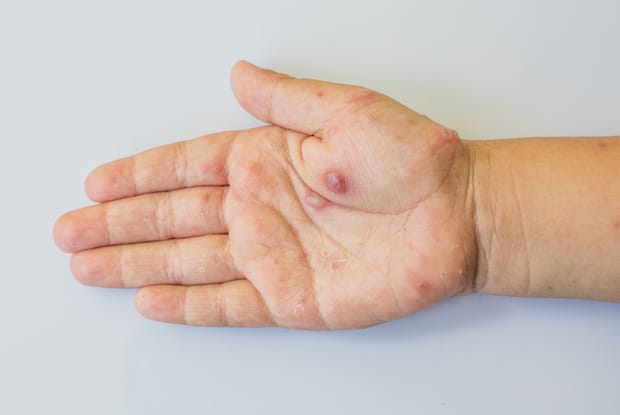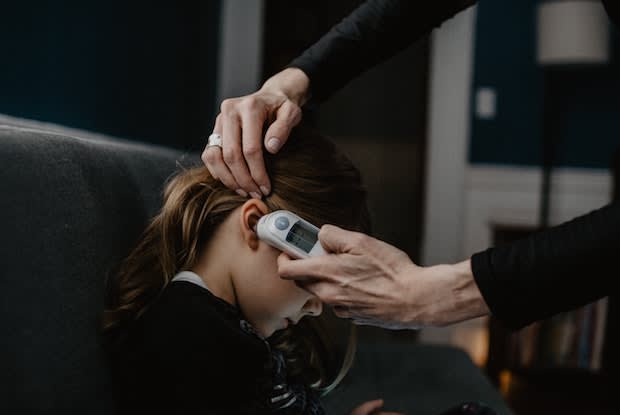Table of Contents
II. What’s the Deal with Shingles?
How Common is Chickenpox?
Chickenpox is a contagious disease that results in an itchy, blister-like rash. In 1996 the chickenpox vaccine was approved for mass use, which has greatly reduced the number of hospitalizations and deaths from this disease. Before these vaccinations began, there were over 100 deaths a year from chickenpox. The vaccine has decreased the rate of deaths by over 90 percent. Over 4 million people got chickenpox each year before 1996, but now there are less than 350,000 cases a year. The chickenpox vaccine involves two doses that can help people avoid contracting the disease. [1]
Chickenpox is an unpleasant condition that is caused by the varicella-zoster virus. This virus creates small, fluid-filled blisters on the skin that are highly contagious. Because it is so contagious, most states require a vaccine before a child can begin to start public school. If you develop chickenpox as a child, you may develop shingles later in life. Luckily, there are several medications like Zovirax (Acyclovir), Valtrex (Valacyclovir), or Famvir (famciclovir). Learn more about these two diseases below. [2]
The same varicella-zoster virus causes shingles and chickenpox. Because the chickenpox vaccine was only approved in the 90s, many older people have never been vaccinated for this virus. If an adult over 40 years old or so had chickenpox as a child, they are at an increased risk for developing shingles.
What’s the Deal with Shingles?
Get savings updates for Valtrex
In the 1950s, researchers found that the varicella-zoster virus can lie dormant for decades. When you recover from childhood chickenpox, that virus stays in the body, residing in nerve cells. Doctors are not sure what causes the virus to reactivate, but it is thought that age weakens nerves, releasing the virus back into the body as we get older. This happens so often that almost half of all people 85 years and older have had shingles. There is also a shingles vaccine available to prevent this virus from reactivating. Not all vaccines are 100 percent effective, but it can greatly reduce your chances of experiencing these diseases. [3]
Symptoms
a. Chickenpox Symptoms
Chickenpox is spread through close contact with others, making it most common in children. Symptoms of this condition typically occur 10 to 21 days after exposure to an infected person. It takes around 5 to 10 days for the chickenpox virus to run its course. The first signs and symptoms include:
- Fever
- Headache
- Tired feeling
- Loss of appetite [2]
Once these initial symptoms occur, a rash can appear all over the body. Chickenpox occurs in stages, and clusters of spots may develop and heal at different times. Along with the rash, the following may also occur:
- Red, small, and itchy spots appear in clusters on the limbs, chest, face, and stomach.
- Blisters may then appear on the top of the spots, which can become very itchy.
- After 48 hours, these blisters will cloud over, and a crust develops.
- After ten days, the crust will fall off, and the skin will begin to heal. [4]
The same virus may cause shingles, but it does present different symptoms. Pain is usually the first symptom. Many people may mistake this pain for a heart, lung, or kidney problem. Some people may experience this pain without ever developing a rash. This rash may wrap around the torso, eyes, or side of the neck or face. Other symptoms may include: Those who have not already had chickenpox are at a higher risk of contracting the disease, as well as those who are not vaccinated. It is important to get a vaccination if you work with children or in a school setting. It is rare to get this condition more than once. [2] Unlike chickenpox, there are several more risk factors for shingles. As mentioned above, anyone who has had chickenpox is at risk for shingles. This disease usually occurs in older people, and risk factors may include: In most cases, chickenpox in children does not require treatment. Shingles may be more serious and require the use of antiviral drugs to speed up the healing process and reduce your risk of complications. Common antivirals include Zovirax (Acyclovir), Valtrex (Valacyclovir), or Famvir (famciclovir). These drugs can help treat shingles rash as well as outbreaks of viral herpes cold sores or fever blisters. If you suspect you are experiencing shingles, it is essential to present all symptoms to your doctor so they can make a proper diagnosis. Sometimes, chickenpox can cause complications that may occur in infants, adolescents, pregnant women, adults, and people with weakened immune systems. Hospitalizations may occur due to: In the case of shingles, long-lasting complications can occur if shingles are left untreated for long periods. Complications can include: The content in this article is intended for informational purposes only. This website does not provide medical advice. In all circumstances, you should always seek the advice of your physician and/or other qualified health professionals(s) for drug, medical condition, or treatment advice. The content provided on this website is not a substitute for professional medical advice, diagnosis, or treatment.
b. Shingles Symptoms
Risk Factors
Treatment

a. Complications
